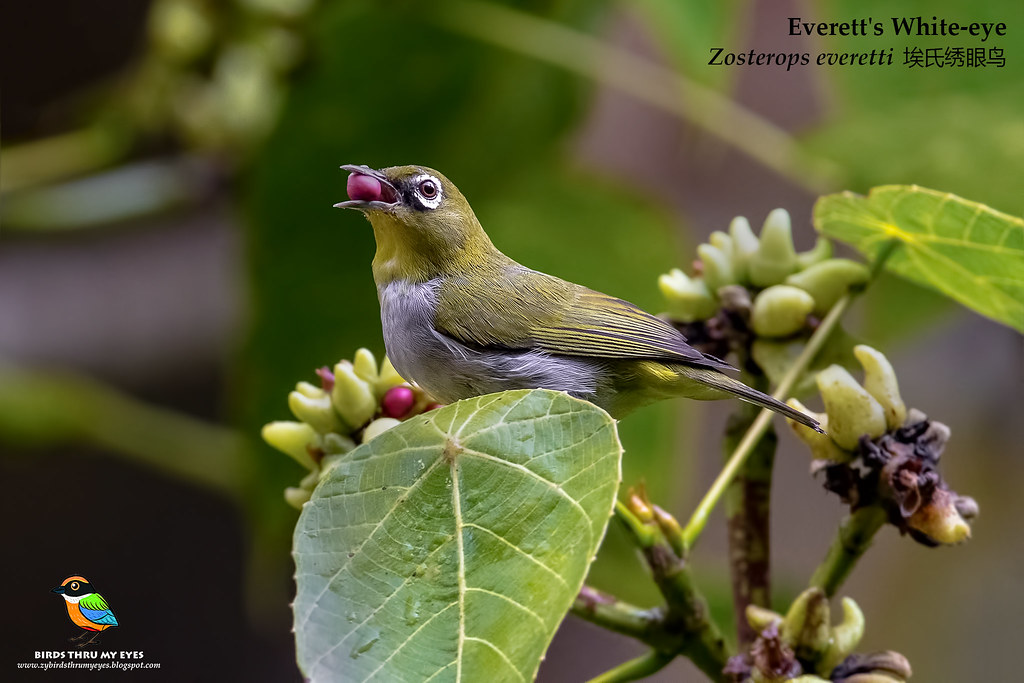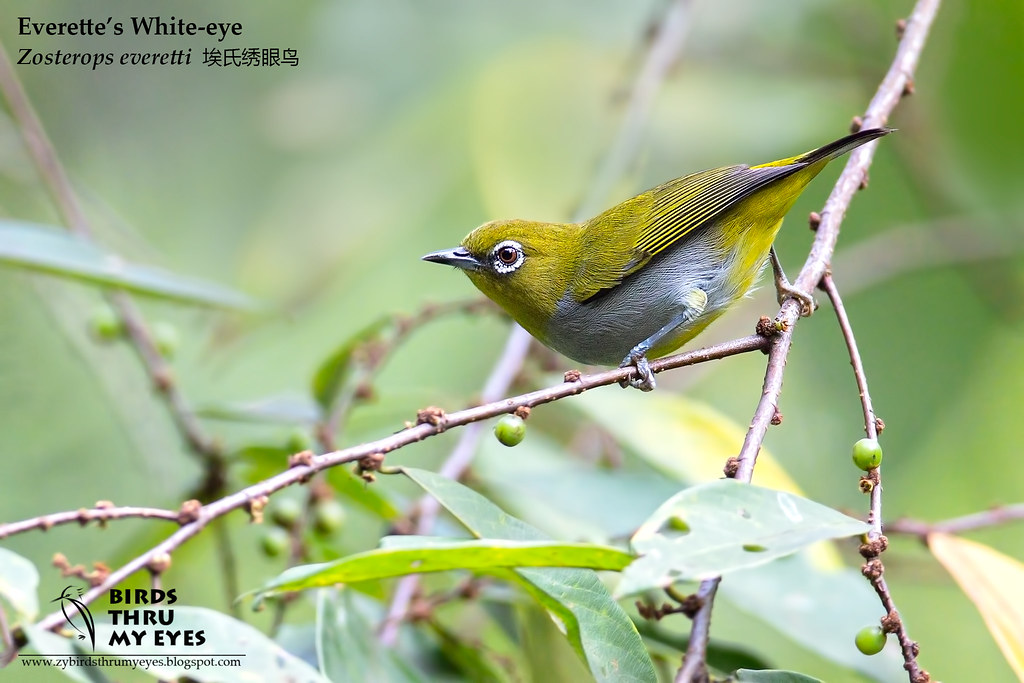Order - Passeriformes
Family - Zosteropidae (White-eyes)
Family - Zosteropidae (White-eyes)
Hume’s White-eye
Zosterops auriventer
休氏绣眼鸟 (xiū shì xiù-yǎn-niǎo)
Malay : Kelicap-Kacamata Rimba Melayu
Japanese : キムネメジロ (ki-mune me-jiro)
Kanji 日語漢字 : 黄胸目白
Size : 11-11.5 cm, 7.8-12 g
Subspecies and Distribution
- Zosterops auriventer wetmorei (Deignan, 1943)
– SC continental Thailand (Khao Yai National Park (5) ) and peninsular Thailand (S to Trang); probably also S Myanmar (Tenasserim).- Identification :
– Similar to tahanensis, but with slightly larger bill.
- Identification :
- Zosterops auriventer tahanensis (Ogilvie-Grant, 1906)
– Extreme S Thailand (Yala), Peninsular Malaysia, and Borneo (Sabah, and locally C, E and S Kalimantan).- Identification :
– Has dusky (instead of black) line under eye-ring, and black bill; has relatively short tail, rectrices without greenish margins, no yellow on forehead and over black lores, legs blue-grey.
- Identification :
- Zosterops auriventer medius (Robinson and Kloss, 1923 [type locality = Mount 'Sidong' (=Sadong), Samarahan Division, south-west Sarawak])
– Borneo.- Identification :
– Overall similar to nominate auriventer, but with darker, more olive-green upperparts.
- Identification :
- Zosterops auriventer auriventer (A. O. Hume, 1878)
– Poorly known; documented only from southeastern Myanmar.
Zosterops auriventer ssp. tahanensis
Date : 03 February 2018
Date : 03 February 2018
Location : Hutan Lipur Sungai Sedim, Mukim Karangan, Daerah Kulim, Kedah
Zosterops auriventer ssp. tahanensis
Date : 17 January 2016
Date : 17 January 2016
Location : Taman TAR, Ampang, Daerah Hulu Langat, Selangor
††Indian White-eye Zosterops palpebrosus
- Zosterops palpebrosus occidentis northeastern Afghanistan east to western Himalayas, and northern and central India
- Zosterops palpebrosus palpebrosus central and eastern Himalayas east to southern China (Sichuan, Yunnan) and Myanmar; isolated populations on Mahawt Island, Oman, and in southern Iran have been assigned to nominate palpebralis, although this requires confirmation
- Zosterops palpebrosus nilgiriensis western India (Western Ghats); most populations elsewhere in southern peninsular India are more or less similar
- Zosterops palpebrosus salimalii SE India (se Hyderabad)
- Zosterops palpebrosus egregius Sri Lanka
- Zosterops palpebrosus siamensis southern Myanmar east through Indochina
- Zosterops palpebrosus nicobaricus Andaman and Nicobar islands
†Hume’s White-eye Zosterops auriventer
- *Zosterops auriventer auriventer poorly known; documented only from southeastern Myanmar
- *Zosterops auriventer tahanensis southern Thai-Malay Peninsula
- *Zosterops auriventer wetmorei southern Thailand and the northern Thai-Malay Peninsula
- *Zosterops auriventer medius Borneo
†Sangkar White-eye Zosterops melanurus
- *Zosterops melanurus buxtoni western Java; a population on Sumatra also has been assigned to buxtoni, but the identification of Sumatran birds as buxtoni has been questioned
- *Zosterops melanurus melanurus Mts. of central and e Java and Bali
††Warbling White-eye Zosterops japonicus
- Zosterops japonicus japonicus southern Sakhalin Island, Japan, and the southern Korean Peninsula; partially migratory, withdrawing from Sakhalin Island and northern Japan in the nonbreeding season
- Zosterops japonicus stejnegeri Izu Is. (s Japan); introduced to Bonin Is.
- Zosterops japonicus insularis Ryukyu Is. (Tanegashima and Yakushima)
- Zosterops japonicus loochooensis Iriomote (Ryukyu Is.)
- Zosterops japonicus alani Volcano Is. (Iwo Jima and Minami-iwo-Jima)
- *Zosterops japonicus daitoensis Daito Is. (Philippine Sea)
- *Zosterops japonicus obstinatus Moluccas (Ternate, Bacan and Seram)
- *Zosterops japonicus montanus central Sumatra, Java, Bali, Sulawesi, Sula Is., Buru, Lombok, Sumbawa, Flores, Timor
- Zosterops japonicus difficilis S Sumatra
- *Zosterops japonicus parkesi SW Philippines (Palawan)
- *Zosterops japonicus whiteheadi N Philippines (n Luzon)
- *Zosterops japonicus diuatae S Philippines (n Mindanao)
- *Zosterops japonicus vulcani S Philippines (Mt. Apo and Mt. Katanglad on Mindanao)
- *Zosterops japonicus pectoralis Philippines (n Negros)
- *Zosterops japonicus halconensis Philippines (Mindoro)
††Swinhoe’s White-eye Zosterops simplex
- *Zosterops simplex simplex breeds in eastern China (from extreme southern Gansu east to Jiangsu, south to eastern Yunnan, Guangxi, Guangdong and Fujian), Taiwan, and northeastern Vietnam; northern populations migratory, wintering from southeastern China to Thailand and central Indochina
- *Zosterops simplex hainanus Hainan (s China)
- *Zosterops simplex williamsoni southern Thailand and east coast of northern and central Thai-Malay Peninsula
- *Zosterops simplex erwini coastal forests of the western and southeastern Thai-Malay Peninsula, of Sumatra, the Riau Islands, Bangka, and the Natuna Islands; population of coastal western Borneo provisionally assigned here, but possibly a distinct taxon
- *Zosterops simplex salvadorii Enggano and Mega islands (off w Sumatra)
Lowland White-eye Zosterops meyeni
- Zosterops meyeni batanis Lüdao (Green) and Lanyu (Orchid) Islands (southeast of Taiwan) and Batan islands (Philippines, north of Luzon)
- Zosterops meyeni meyeni Philippines (Calayan, Luzon, Lubang, Verde, Marinduque, Banton, and Caluya)
Everett’s White-eye Zosterops everetti
- Zosterops everetti everetti Philippines (Cebu)
- Zosterops everetti basilanicus Philippines (Basilan, Dinagat, Mindanao, Siargao, Camiguin Sur)
- Zosterops everetti boholensis Philippines (Bohol, Leyte, Samar, Calicoan and Biliran)
- Zosterops everetti siquijorensis Philippines (Siquijor)
- Zosterops everetti mandibularis Sulu Archipelago (Sulu, Tawitawi, Jolo, Bongao, Sanga Sanga)
- Zosterops everetti babelo Talaud Is. (Karakelong and Salebabu) and n Sulawesi
Ashy-bellied White-eye Zosterops citrinella
- *Zosterops citrinella unicus W Lesser Sundas (Sumbawa and Flores)
- Zosterops citrinella citrinella Lesser Sundas (Timor, Rote, Sawu and Sumba)
- Zosterops citrinella albiventris Tanimbar Is. and islands off n Queensland south to Lizard I.
- Zosterops citrinella harterti Alor (e Lesser Sundas)
Indian/Swinhoe’s White-eye Zosterops palpebrosus/simplex
_________________________________________________________
In one more attempt to help this all make sense, or for those who don’t like cooking, below is a chart of how your records may have changed by country:
- If you had reported Japanese White-eye (Z. japonicus) from Russia, Japan, South Korea, Taiwan, Indonesia, or Hawaii, USA, those records will now show as Warbling White-eye Zosterops japonicus
- If you had reported Japanese White-eye (Z. japonicus) from China, Hong Kong, Taiwan, Vietnam, Laos, Cambodia, Myanmar, or Thailand, or introduced populations from California, USA* or Singapore, those records will now show as Swinhoe’s White-eye Zosterops simplex [* note – California records from San Diego County from prior to 2006 pertain to Indian White-eye Z. palpebrosus).
- If you had reported Mountain White-eye (Z. montanus) from anywhere, it will now show as Warbling White-eye (Zosterops japonicus)
- If you had reported Oriental White-eye (Z. palpebrosus) from anywhere west of Thailand (e.g., India, Bhutan, Nepal, Pakistan, Myanmar, Bangladesh etc.) those will now appear as Indian White-eye Zosterops palpebrosus.
- If you had seen Oriental White-eyes (Z. palpebrosus) in mangrove or coastal habitat in s. Thailand, s. Myanmar, Malaysia, Singapore, Sumatra, or on Borneo, those will now appear as Swinhoe’s White-eyes Zosterops simplex. Note that these birds have a yellow ventral stripe, while inland, migratory Swinhoe’s do not.
- If you had Oriental White-eye from Java, Sumatra (inland areas, not coastal ones), or Bali, then those are now Sangkar White-eye Zosterops melanurus melanurus
- If you had reported Everett’s White-eye (Z. everetti) from either of two popular parks in Thailand–Khao Yai NP or Kaeng Krachan NP–these will now appear as Hume’s White-eye Zosterops auriventer, as will any others from peninsular Thailand, Malaysia, Singapore, or Borneo. Please note also that many observers also seem to have reported Oriental White-eye Z. palpebrosus from those areas; it was only recently discovered (in 2004, see the paper here) that subspecies wetmorei was the predominant white-eye in Khao Yai (other than Chestnut-flanked) and no other similar species have been found in either area before or since. Because of this, we have converted all reports of Oriental White-eye to Hume’s White-eye from those areas as well.
- If you had any of the following:
- Any Oriental White-eyes from Sumbawa and Flores in the Lesser Sundas, this would be subspecies unicus, which is now moved to Ashy-bellied White-eye Zosterops citrinella
- Any sightings of Enggano White-eye (Z. salvadorii) then these are now Swinhoe’s White-eye Zosterops simplex.
- Mountain White-eye from Marinduque (Phillippines), then these are subspecies gilli which is now Lowland White-eye Zosterops meyeni



No comments:
Post a Comment